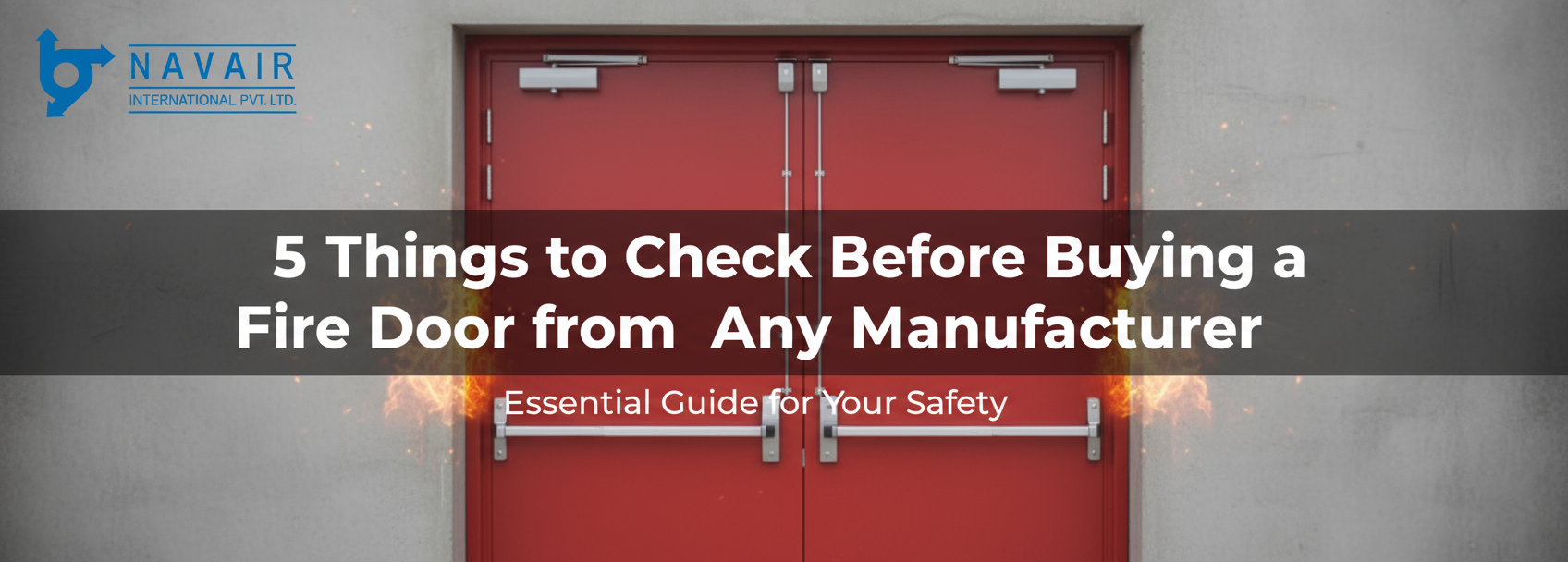Fire Door
When you’re investing in fire doors, you’re not just buying a product—you’re relying on features that can save lives, protect property, and ensure legal compliance. Whether you are in Delhi, Mumbai, Chennai, Pune, Bangalore, or Hyderabad, here are the 5 essential things you must check before selecting any fire door manufacturer.
- Compliance with Standards & Certifications
Why It Matters:
Fire doors are regulated by national and international safety codes. If a door isn’t certified, it may fail prematurely during fire. In India, the key standard is IS 3614:2021 — Fire Doors and Doorsets-Specification. Under the National Building Code (NBC) 2016, fire doors must meet specific Fire Resistance Ratings (FRR) of 30, 60, 90, or 120 minutes depending on location, occupancy, and hazard risk.
What to Check:
- Look for the BIS (Bureau of Indian Standards) mark on the door certificate. Doorsets should meet IS 3614:2021.
- If the door has glazing, ensure the fire-rated glass is tested as part of the whole assembly.
- Check for third-party lab testing (e.g., CBRI, NABL-accredited labs) confirming the fire rating.
- Fire Resistance Rating & Materials
Why It Matters:
A fire door’s rating tells how long it can resist fire while maintaining integrity. The material and core type influence performance—wood cores, steel, or composite materials behave differently under heat. Under NBC / IS 3614, doors must meet the required hourly rating depending on the location.
What to Check:
- The fire rating (30 min, 60 min, 90 min, 120 min) must be clearly mentioned.
- Core material: solid hardwood, engineered wood, mineral wool, or steel with fire-rated infill.
- In steel door: check thickness, insulation, thermal performance. In wooden door: treated wood or fire‐retardant coating.
- Door Assembly: Frames, Seals, Hardware & Installation
Why It Matters:
A fire door is not just the door leaf. The frame, seals, hardware (hinges, closers, latches), smoke / intumescent seals, glazing and installation all contribute to overall performance. Even a well tested door fails if installed poorly or hardware is not compatible.
What to Check:
- The frame material (steel or equivalent fire rated frame) with matching fire resistance.
- Intumescent strips or seals around the edges to prevent smoke/gas leakage. Self-closing device: the door should close from any open angle and latch properly; manual or electromagnetic hold-open systems must release when alarm triggers.
- Gap tolerances: side/top clearances and bottom clearance as specified by the standard. Smaller gaps help prevent heat/smoke ingress.
- Manufacturer Reputation and After-Sales Support
Why It Matters:
Even the best fire door loses its reliability without having proper maintenance, servicing, and support. reputed manufacturers usually offer reliable service, hardware (like seals, closing devices), warranties and certification of installed products. Also, feedback from local projects (Delhi, Mumbai, etc.) gives insight into what to expect.
What to Check:
- Track record of the manufacturer: how many years, what kind of projects (commercial / residential / institutional).
- Warranty terms & availability of hardware.
- Whether they provide installation guidance or also offer installation services. Misinstallation can void certification.
- Maintenance requirements: frequency of inspections, seal replacement, hardware check.
- Customization, Aesthetics, and Value
Why It Matters:
Fire doors often have to blend with interiors or facades. Customers often need glazed panels, decorative finishes, flush or wood grain appearance, color matching. But customization shouldn’t compromise safety or add excessive cost. Having the right balance between form, function, and cost is key.
What to Check:
- The ability of the manufacturer to provide finishes or glazed panels while maintaining the required fire rating.
- Options in door design: flush doors, glazed doors, steel / wood mix, decorative hardware.
- Cost vs quality: what is included in the quoted price (door leaf, frame, hardware, seals, installation). Sometimes lower price excludes hardware or glazing.
- Delivery timelines and location support (local fire door manufacturers in Delhi, Pune, etc., often provide faster turnaround).
Putting It All Together: Decision Checklist
Here’s a simple checklist you can use when you’re evaluating any fire door manufacturer:
| Item |
Must Confirm |
| Standard / certification (IS 3614, BIS mark, NBC 2016) |
Yes |
| Fire Rating (minutes) matches use case |
Yes |
| Material & core type (steel / wood / composite) |
Yes |
| Complete assembly: frame, hardware, seals, glazing |
Yes |
| Self-closing mechanism + proper fit/gaps |
Yes |
| Manufacturer’s reputation + after-sales support |
Yes |
| Customization, aesthetics, delivery & cost transparency |
Yes |
Case Examples & Trends in Indian Cities
- In Delhi NCR, many high-rise commercial projects insist on FD-90 or FD-120 steel fire doors with glazed panels for corridor and lift lobbies.
- In Mumbai and Bangalore, wood finish fire doors are popular in residences and boutique offices, provided they meet treatment and rating requirements.
- Cities like Ahmedabad, Chennai, Hyderabad, Pune often rely on local manufacturers who can supply and install quickly; certifications and inspections are increasingly demanded by local fire authorities.
navair2020
5-Oct-2025
190 Views
